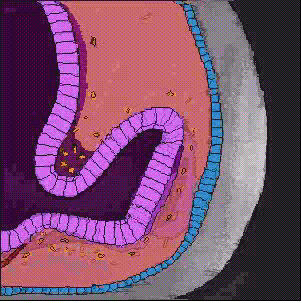Cell Biology & Histology A560
|
Specialized Sensory Organs, the Eye and the Ear |
|
|
 The
eye and the ear are the two most complex “organs of special sense.”
The eye is derived from an outpocketing of the early embryonic brain
and its unique and highly complex structure reflects its origin. In
studying a histological section of the eye, one must keep in mind
the fact that, in the living state, the anterior portion of the eye
is filled with fluid which is being continually produced and
absorbed.
The animated image to right is courtesy
of
Loyola University of
Chicago, and demonstrates the developmental stages of the human
eye. The
eye and the ear are the two most complex “organs of special sense.”
The eye is derived from an outpocketing of the early embryonic brain
and its unique and highly complex structure reflects its origin. In
studying a histological section of the eye, one must keep in mind
the fact that, in the living state, the anterior portion of the eye
is filled with fluid which is being continually produced and
absorbed.
The animated image to right is courtesy
of
Loyola University of
Chicago, and demonstrates the developmental stages of the human
eye.
Learning Objectives for the eye:
- Understand the overall
organization of the eye and the structural-functional significance
of the three layers present.
- Recognize the structure of the
cornea, lens, and vitreous body.
- Understand the structure of the
components of the iris and ciliary body and their functions in
accommodation and pupil dilation/constriction.
- Understand the structures involved
in aqueous humor formation, movement, and removal.
- Understand the relationship among
the choroid and the pigmented and sensory layers of the retina.
- Recognize and understand the
functional significance of the cells within the sensory retina,
particularly the rods and cones, bipolar cells, and ganglion
cells, their interconnections and relationship to the fovia
centralis and optic nerve.
Next, the ear. |
|